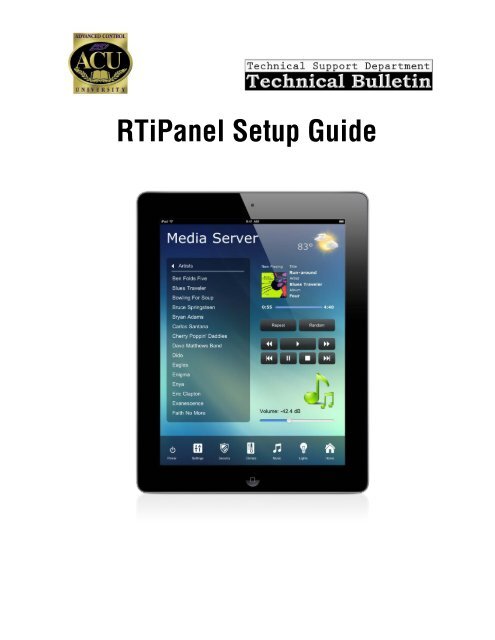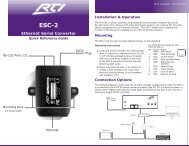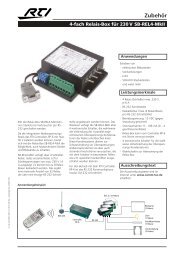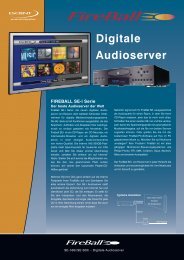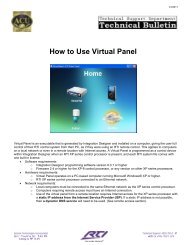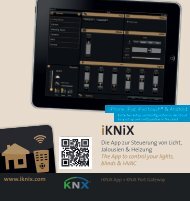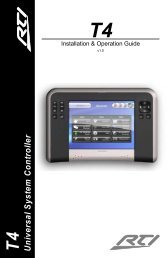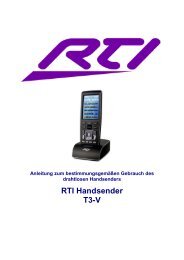RTiPanel User Guide - Comm-Tec
RTiPanel User Guide - Comm-Tec
RTiPanel User Guide - Comm-Tec
Create successful ePaper yourself
Turn your PDF publications into a flip-book with our unique Google optimized e-Paper software.
<strong>RTiPanel</strong> Setup <strong>Guide</strong>
Table of Contents<br />
<strong>RTiPanel</strong> Overview and Requirements.......................................................................................................... 3<br />
Software Requirements: ........................................................................................................................... 3<br />
Hardware Requirements: .......................................................................................................................... 3<br />
Network Requirements: ............................................................................................................................ 3<br />
Licensing Requirements: ........................................................................................................................... 3<br />
Basic Integration Designer Programming ..................................................................................................... 4<br />
Adding an <strong>RTiPanel</strong> Device to System ....................................................................................................... 4<br />
Adding <strong>RTiPanel</strong> Licenses to System ......................................................................................................... 4<br />
Configuring ® iPad ® , iPhone ® or iPod touch ® Device ....................................................................................... 5<br />
Re-Configuring Device ............................................................................................................................... 7<br />
Advanced Integration Designer Programming.............................................................................................. 8<br />
Gauge Drawing Tool .................................................................................................... 8<br />
Slider Drawing Tool ................................................................................................... 8<br />
Toggle Button Drawing Tool ...................................................................................... 8<br />
One-Way List Drawing Tool ..................................................................................... 8<br />
Two-Way List Drawing Tool ...................................................................................... 9<br />
<strong>RTiPanel</strong> Password .................................................................................................................................... 9<br />
Locking Orientation ................................................................................................................................. 10<br />
Hiding Buttons for an Orientation .......................................................................................................... 10<br />
Remote Access Setup .................................................................................................................................. 12<br />
Dynamic Name Service ........................................................................................................................... 12<br />
Setting up DynDns Account ................................................................................................................ 12<br />
Setting up DnyDns on Router .............................................................................................................. 12<br />
Network Router Setup (Port Forwarding) ............................................................................................... 12<br />
Integration Designer Setup ..................................................................................................................... 12<br />
Setting External Hostname ................................................................................................................. 12<br />
Setting External Gateway .................................................................................................................... 12
<strong>RTiPanel</strong> Overview and Requirements<br />
<strong>RTiPanel</strong> is an iOS application that is designed to run on iPad and iPhone devices. This application<br />
communicates with RTI’s XP series control processors to provide full control of your RTI system right<br />
from your iPad or iPhone. The <strong>RTiPanel</strong> application is designed to run on LAN and WAN networks giving<br />
full control and two-way feedback from anywhere in the world. A license is required for every Apple<br />
device in order to communicate. Licenses may be purchased from the RTI online store.<br />
Software Requirements:<br />
• Integration Designer programming software version 8.2 or higher<br />
• Any version of XP-3 processor firmware.<br />
• Firmware 1.1 or higher for the XP-6 control processor<br />
• Firmware 3.0 or higher for the XP-8 control processor<br />
Hardware Requirements:<br />
• The <strong>RTiPanel</strong> for Apple ® devices is programmed on a PC based computer running Windows<br />
XP or higher<br />
• Apple ® iPad ® , iPhone ® and iPod touch ® device<br />
• RTI XP3, XP6, or XP8 control processor<br />
• When using an XP8 processor, you must install an SD card into the front on the XP8. The SD<br />
card provides additional file space needed to store <strong>RTiPanel</strong> datafiles.<br />
Network Requirements:<br />
• Local Apple ® devices must be connected to the same Ethernet network as the XP series control<br />
processor.<br />
• Apple ® devices requiring remote access must have an Internet connection.<br />
• Use of the <strong>RTiPanel</strong> from a remote location requires Internet access for the XP series processor<br />
with a static IP address from the Internet Service Provider (ISP). If a static IP address is not<br />
possible, then a dynamic DNS service will need to be used. (See the Remote Access section for<br />
details.)<br />
Licensing Requirements:<br />
• A license is required for each ® iPad ® , iPhone ® or iPod touch ® device.<br />
• Licenses may be purchased online at (web link).
Basic Integration Designer Programming<br />
Creating a system that includes an <strong>RTiPanel</strong> device starts with a system file containing an XP series<br />
processor. From there, you simply add the Apple device like you would any other RTI device. Next, add<br />
an <strong>RTiPanel</strong> license and your ready to connect.<br />
Adding an <strong>RTiPanel</strong> Device to System<br />
From the ‘Device’ menu select ‘Add New’. In the ‘Add New’ dialog box, find the ‘Virtual Controls’<br />
section. Choose the Apple device you wish to add to the file.<br />
Adding <strong>RTiPanel</strong> Licenses to System<br />
From the ‘File’ menu select ‘System Properties’. Go to the ‘iOS/Virtual Panel’ tab. Find the ‘Licenses’<br />
section. Press the ‘Add’ button to add your license file.
Configuring ® iPad ® , iPhone ® or iPod touch ® Device<br />
Configuring your Apple device is quick and easy. Start by downloading the <strong>RTiPanel</strong> app from the iTunes<br />
app store. When you start the application you will see a screen with two buttons. Choose the ‘Get<br />
Started’ button.<br />
The next screen will show a list of RTI XP processors that are on the LAN and are available to connect to.<br />
If you are configuring remotely, you can add the DNS hostname directly by selecting the ‘+’ button in the<br />
upper-right corner of the screen.<br />
Once a server has been selected, it will provide a list of devices compatible with the hardware running<br />
the <strong>RTiPanel</strong> app. If the <strong>RTiPanel</strong> is running on an iPhone4 device, the list will show both iPhone and<br />
iPhone4 devices.
Finally, select the desired device. The configuration will be downloaded to the device and the device<br />
will be “configured”. The <strong>RTiPanel</strong> app will check-in with the server after each connection is made to<br />
determine if a new configuration is available. If a new configuration is available, it will be downloaded<br />
automatically by the <strong>RTiPanel</strong> app.
Re-Configuring Device<br />
In the event that the <strong>RTiPanel</strong> needs to connect to a different server, the configuration can be reset.<br />
Resetting the configuration will cause the <strong>RTiPanel</strong> to return to the “Welcome” screen, allowing you to<br />
go through the configuration steps again. The “Reconfigure” option automatically resets itself to “Off”<br />
when you go back to the <strong>RTiPanel</strong> app.
Advanced Integration Designer Programming<br />
There are several features that are unique to Apple® device programming. These programming tools<br />
will appear in the bottom left tool pallet within the Integration Designer programming software only<br />
when programming an Apple® device.<br />
Gauge Drawing Tool<br />
To add a gauge object to a page, select the gauge drawing tool in the lower-left corner of the Integration<br />
Designer window. Now select the ‘Draw Button’ tool. Draw the gauge on the page to the desired size.<br />
The orientation of the gauge will change depending on the size of the button. To make the gauge<br />
orientation bottom-to-top, simply draw the button tall and skinny. Gauge objects are for feedback only.<br />
You cannot place a command onto the gauge object.<br />
Slider Drawing Tool<br />
To add a slider object to a page, select the slider drawing tool in the lower-left corner of the Integration<br />
Designer window. Now select the ‘Draw Button’ tool. Draw the slider on the page to the desired size.<br />
The orientation of the slider will change depending on the size of the button. To make the slider<br />
orientation bottom-to-top, simply draw the button tall and skinny. Once the slider has been created,<br />
driver commands and feedback variables can be assigned.<br />
Toggle Button Drawing Tool<br />
To add a Toggle Button object to a page, select the switch object drawing tool in the lower-left corner of<br />
the Integration Designer window. Now select the ‘Draw Button’ tool. Note that while the actual button<br />
can be drawn to the desired size, the toggle button graphic itself is a fixed size. Once the toggle button<br />
has been created, driver commands and feedback variables can be assigned.<br />
One-Way List Drawing Tool<br />
To add a One-Way List object to a page, select the static list object drawing tool in the lower-left corner<br />
of the Integration Designer window. Now select the ‘Draw Button’ tool. Draw the one-way list object on<br />
the page to the desired size. A one-way list can then be populated by right clicking on the scrolling list<br />
object and selecting “Edit Scrolling List”. A programming menu similar to the illustration below will<br />
appear and allow for the creation of macro commands to be executed when an item from the list is<br />
selected. Button Text and bitmap fields are also available for customization of the scrolling list. Oneway<br />
scrolling lists can be an ideal interface for control requirements that would otherwise require many<br />
fixed buttons (ex: favorite music or tv stations, surround modes from an A/V receiver).
Two-Way List Drawing Tool<br />
To add a Two Way List object to a page, select the static list object drawing tool in the lower-left corner<br />
of the Integration Designer window. Now select the ‘Scrolling List Object’ tool. Draw the two-way list<br />
object on the page to the desired size. Once created, driver commands and item list feedback variables<br />
can be assigned to the list for two-way communication with compatible desired equipment.<br />
Additionally, the button text properties (text size, font, alignment) can be adjusted by right clicking on<br />
the two-way list button, and selecting “Edit Properties”.<br />
<strong>RTiPanel</strong> Password<br />
<strong>RTiPanel</strong> can provide secure access via the “Security” tab of the Device Properties for each Apple®<br />
device. When <strong>RTiPanel</strong> application is open and the password option has been enabled, a prompt will<br />
ask for the password entry before the user interface is presented. Note that the password prompt will<br />
only be initiated upon starting of the <strong>RTiPanel</strong> application. If the <strong>RTiPanel</strong> has been opened and is<br />
running in the background of iOS, a “new” prompt will not be required when the user chooses to use the<br />
<strong>RTiPanel</strong> application. In the event that secure access to the control interface is important, the user<br />
should completely close <strong>RTiPanel</strong> in iOS after each use (i.e. <strong>RTiPanel</strong> should not be still running in the<br />
background).
Locking Orientation<br />
<strong>RTiPanel</strong> supports unique GUI layout for both Portrait and Landscape mode on Apple® devices. Both<br />
Portrait and Landscape mode are enabled by default on each Apple® device. The GUI for each<br />
orientations must be programmed when both modes are enabled, which in general will require<br />
additional programming time. If a fixed graphics orientation is preferred, right click on the Apple®<br />
device in the System Workspace of Integration Designer, and select “Edit Properties”. From the General<br />
tab, select the preferred orientation. Once selected, only the desired orientation needs to be<br />
customized in Integration Designer.<br />
Hiding Buttons for an Orientation<br />
When auto-rotation is enabled for the Apple® device, each button will be visible in both Portrait and<br />
Landscape mode by default. If a button should only be visible in one orientation, right click on the<br />
button, and select “Edit Properties”. From the General tab, uncheck the view in which the button<br />
should NOT appear.
Remote Access Setup<br />
Dynamic Name Service<br />
The first step when setting up remote access is to create a Dynamic Name Service (DNS) account with a<br />
DNS server like DynDns.com. When setting up your DNS account you will receive a DNS hostname. This<br />
hostname is what you will use when setting up the <strong>RTiPanel</strong> in Integration Designer.<br />
Setting up DynDns Account<br />
Go to the DynDns website (http://dyn.com) . Navigate to the account setup page and create a new<br />
account. Enter the IP address found on your router. This IP address is the external address given to the<br />
router by the ISP. This IP address will be updated automatically by your router.<br />
Setting up DnyDns on Router<br />
Once you have setup a DynDns account, you must provide your router with the new account<br />
information. In your router setup, navigate to the DNS setup page. You may see a list of supported DNS<br />
services. Choose ‘DynDns’. Then enter the username and password information. The router will log<br />
into your DynDns account whenever the IP address changes.<br />
Network Router Setup (Port Forwarding)<br />
The next step is to setup the port forwarding entry in your router. Logon to your router using a web<br />
browser and look for the ‘port forwarding’ setup. The router must be configured to forward packets<br />
from port 4110 to the gateway XP processor. A typical port forward configuration entry would look like<br />
this:<br />
Application: <strong>RTiPanel</strong><br />
Port: 4110<br />
Destination: 192.168.1.200 (IP address of gateway XP processor)<br />
Integration Designer Setup<br />
The last step is to enter the DNS hostname into your Integration Designer system file.<br />
Setting External Hostname<br />
Under the ‘File’ menu choose ‘System Properties’. On the iOS/Virtual Panel tab, find the ‘Remote<br />
Access’ section. Enter the hostname provided by your DNS account. You can also enter the IP address<br />
directly but we do not recommend that.<br />
Setting External Gateway<br />
If you have more than one XP series processor in your file, you can designate which processor will act as<br />
the gateway for iOS communications. Remember that the <strong>RTiPanel</strong> licenses are tied to a particular<br />
processor and changing this setting will require new licenses.


